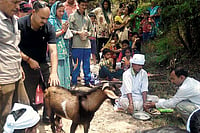Eating involves senses. Wafting aromas trigger anticipation, and eyes take over when the food arrives. The colours and shape stir up memories. The stream of consciousness unravels associations involving people and places. The taste excites different buds. But the most significant part is assigned to hands. The touch and feel dispatches signals that allow the mouth to salivate and gastric juices to flow. Eating with hands encourages ‘mindful eating’ that blends the therapeutic with the aesthetic.
In different regions, the process varies. In the north, where roti is the staple, fingers and thumb are used. In other parts, the palm and forearms may be in action. The habit of eating with hands is ancient. Eons ago, when we were hunters-gatherers, this was the way to gobble food. Only in recent times, and in many countries, people use knives, forks, spoons, and chopsticks. However, as is the norm among several sections, using hands is delectable, yet dangerous. If they are not clean, they become the carriers of deadly diseases and infections.
Our parents and grandparents constantly warned us to carefully wash hands before and after meals. Doctors never tired of underlining the ‘Four Fs’ – faeces, flies, food and fingers – that spread diseases like cholera, typhoid and jaundice. Fingers are possibly the weakest link in this chain. They touch food while cooking, serving and eating. Traditionally, Indians sat down for meals after bathing. The cooks followed similar – even stricter – protocols. This ensured that infections were controlled. Eating out was not encouraged and there were taboos to limit the eating of contaminated food.
Where soap wasn’t available, ash or clay were used as detergents. Food was mostly cooked on wood-fired chulhas, so ash was never in short supply. The dishes were served on plantain leaves or pattal (platters fabricated with stitched leaves), which were washed or rinsed with water. Times have changed, and so have dining habits. Most of us don’t sit in the kitchen, or take a bath before lunch or dinner. Tables, chairs and plates are in vogue. So is the cutlery. There is a false sense of security that we don’t need to wash hands.
But hands invariably play a role. Indian food is designed, or has possibly evolved, to be eaten and enjoyed with hands. Bengalis love their hilsa, or similar bony fish, and those below Deccan plateau spoon over sambar rice. Most of them are compelled to use fingers. And then there are snacks. Samosa, pakora, and kathi rolls are ‘handled’. So is the case with modern fast-food items such as pizza, hamburger, sandwich, patty, and French fries.
However, the kind of food we eat reminds us of how modernity and urbanisation have changed our eating habits. Most of us eat out, at least once a day, because we don’t carry lunches to offices, schools and other workplaces. Since we are in a rush, we grab a bite without thinking about the need to wash hands.
Thanks to Covid, handwashing hygiene sharply came into focus. As the pandemic wrought havoc, we were painfully reminded the surfaces we unconsciously touch during the course of the day – doorknobs, handrails in staircases, buses and suburban trains – may be contaminated. The list is unending, and includes water taps, books, phones, tabletops and shop counters that others have touched before us. Hence, some of us began to emulate Lady Macbeth – compulsively washing hands. A few used elbows and knuckles, instead of hands, to greet each other.
As casualty numbers fell, and the brutality of the pandemic tapered off a bit, at least till now, we seem to return to the old risky ways. Sadly, many have gone back to slippery shortcuts of perfunctorily washing hands with little soap, or ritually spraying hand sanitiser before eating. Swachh Bharat Abhiyan that initially galvanised the nation a few years back is a fading memory. However, government’s exhortations regarding cleanliness and hygiene need to be taken more seriously. It is a matter of life and death for hundreds of millions of people.
Industry associations have launched vigorous campaigns for safe street foods. Those who prepare or handle them are trained to pare nails, wash hands frequently, and use disposable skull caps, face masks and paper gloves. This has contributed to enhanced self-esteem of workers in small outlets, apart from increased safety for consumers. Equal emphasis is laid on washing utensils and garbage disposal. Still, more work remains to be done.
A few restaurants, especially those that serve south Indian food, provide washbasins for guests to wash hands before and after eating. There is no substitute for making hand hygiene an indispensable part of our lives. The WHO has conveyed how to do it the right way. The proper manner is to work up a rich lather, and rub hands vigorously, and pay attention to spaces between fingers. One has to dry hands under a dryer, or use absolutely clean towels. Children have to be trained to wash hands before touching anything they eat. ‘Hand to Mouth’ is the riskiest route that we traverse several times a day.
There is no dearth of excuses for not practising handwashing. How can you waste water? Where is the time to do so? How can we keep others waiting? Think about it! Water can be conserved by manipulating the tap flow, or using a mug. Anyone and everyone can squeeze in a few minutes. If you take the trouble to wash hands, your family, relatives and friends may begin to appreciate the effort, and follow suit. There is no reason why handwashing can’t be a part of shared dining experiences.
Pushpesh Pant Food writer and former professor Jawaharlal Nehru University























